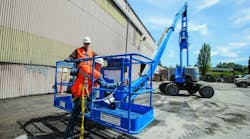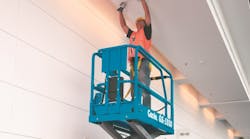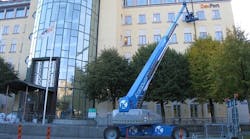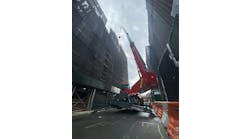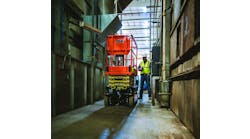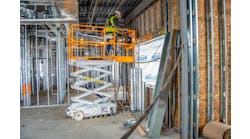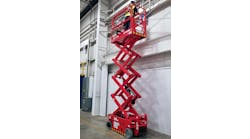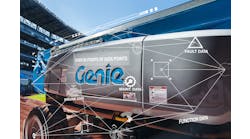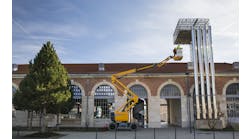Interviews with Aerial Manufacturers: Evolving our Technological Approach
RER Interviews Matt Fearon, president, Terex AWP about the continuing growth of the market for aerial work platforms, new technological trends and the company’s numerous product launches.
RER: How do you assess the current market for aerial work platforms in North America and globally?
Fearon: It’s very positive, and we see a flattening in the U.S. market at these levels pending a more robust non-residential construction cycle. As for outside the U.S., we see good unit growth in Europe being masked by currency translation, weakness in Latin America and Australia, and increasing acceptance in Asia. All in all, still two-thirds of our sales are in North America and the tone is stable at a strong level, with telehandlers pulling back from energy, and other products doing OK.
Where is the market trending upwards and where is it trending downwards?
The seasonally adjusted construction spending shows an increase of about 2 percent from Q1 2014 to Q1 2015. In addition, the construction employment is continuing on a moderate upswing, every year, ongoing since 2010. The IHS Construction outlook estimates 2 to 5 percent growth in various parts of the U.S., with California, Oregon, Arizona, Nevada and Florida expected to see double digit growth. Declining regions in the U.S. are in the north central and northeastern portions of the country.
What is new with Genie in terms of products?
In addition to the engine changes to meet current emissions standards, we have introduced a record-breaking number of new and innovative products this year. We introduced three new booms (the articulating Genie Z-33 and Z-62 boom lifts and the Genie SX-150 boom lift) and the GS-4047 scissor lift to the North American market. Also, we recently announced the completion of our telehandler line with the introduction of two new telehandlers, the Genie GTH-636 and the GTH-1256. We have also updated the look of our product line. In August, we announced our newest light tower, the redesigned Terex RL-4. The light tower is highly compelling as it provides a smaller footprint (17 now fit on a truck instead of 10), longer run time (saving labor to fill fuel tanks) and a faster set up (easy use in the field). All of these products are designed with a focus on our customers’ return on their investment.
Any particular technological trends you would like to talk about, now or future?
The Genie R&D team has evolved our technology approach to continuously adapt proven technologies to improve the ROIC on Genie aerials for our customers. We refer to this as rROIC, for “rental” ROIC, the return for our equipment in a rental fleet. We continuously work with the rental industry to understand how they run their business and then develop robust technologies that focus on machine uptime and provide the highest rROIC.
Structural analysis, testing, and optimization are great examples of where we are taking proven technology from other industries and applying it to our products. It has taken us years to understand and perfect the materials and analysis technologies that make our Genie SX-180 boom lift significantly lighter than the competition providing a host of advantages in transport and component wear. We have developed new ways of analyzing lift structure life and are providing scissors and booms with demonstrated longer life spans. This structural technology is one driver for Genie products’ proven residual values.
Our dedicated controls team takes a host of technologies that are proven robust in other fields and adapts them to rental. You can see this in our approach to telematics where, instead of a complex, brand-specific solution, we bring a set of flexible technologies that adapt to the telematics system a rental fleet is already using. We are adding capability incrementally in simple packages. We have just started introducing our hybrid technologies and these will reflect the same approach with uniquely robust components designed to provide industry-leading performance and efficiency.
How about after-market support and safety initiatives?
Safety is a top priority across Terex, and the Genie team is always looking for ways to meet our customers’ safety requirements. We recently introduced the Genie Fall Arrest Bar, a new secondary protective device that is being met enthusiastically by our customers. We worked extensively with customers to design and test this device and have been able to create a solution that meets their needs. This device is available for ANSI and CSA boom lifts and quickly attaches to a 6-foot or 8-foot platform on all 40-foot Genie telescopic boom lifts and 45-foot Genie articulating boom lifts and higher. The Fall Arrest Bar allows a user to exit the platform and work comfortably around the outside of the platform with a 6-foot lanyard.
As for aftermarket support, we are continuing to offer our Genie Lift Pro Online Operator Training for aerials and telehandlers in both English and Spanish. This program is extremely popular with our customers due to its convenience, efficiency and affordability. We also offer Genie TechProtm service training, which allows our customers to get trained on service aspects of Genie equipment. This allows them to become trained easier and faster, allowing for reduced maintenance costs for the life of the machines.
Do you see any particular new growth markets, in terms of places and market segments where AWP usage is growing or has strong potential for growth?
Both North American residential and non-residential construction have grown moderately every year since 2010. The fastest growing cities in the U.S. are New York, Los Angeles and three cities in Texas, which drive equipment needs in these areas. In addition, the worldwide use of aerial work platforms grew 8 percent from 2014 to 2015, indicating increasing acceptance and use of this equipment.
It doesn’t appear that oil prices are going to surge upwards any time soon. What kind of impact will continued softness in oil and gas have on the aerial market from your perspective?
While the energy sector is going through uncertainty right now, our products are still heavily used in other markets, such as construction and other industrial sectors. In addition, with the introduction of new products this year, like the Z-33 boom lift, we have opened up new markets for our products. For example, the Z-33 boom lift can be used indoors, with its light weight and compact size, in atriums and gymnasiums. In addition, the GS-4047 scissor lift is used extensively in 40-foot warehouses for inventory and maintenance purposes. Customers are also excited about large LNG projects starting on the Gulf Coast, which will drive boom and telehandler usage in these areas.
What new trends of interest do you see in the equipment rental market?
Customers are looking for an excellent return on investment of their equipment. OEMs, such as ourselves, are keenly aware that our equipment needs to provide the best ROIC possible. This means, OEMs need to provide equipment that is high quality, easy to maintain and keeps a good resale value. Genie is able to provide all of these.
